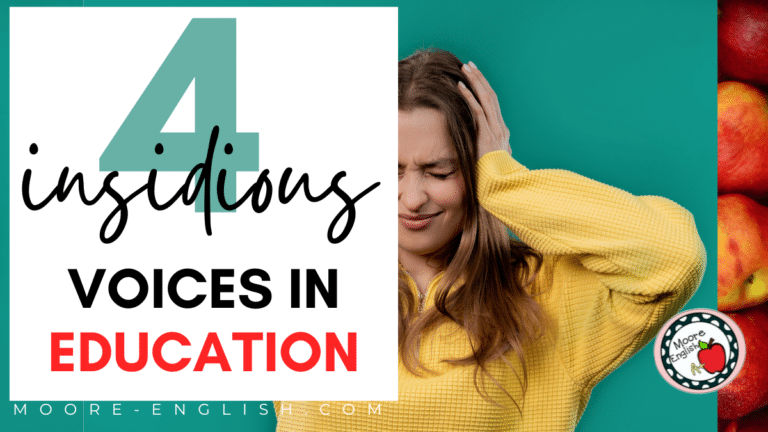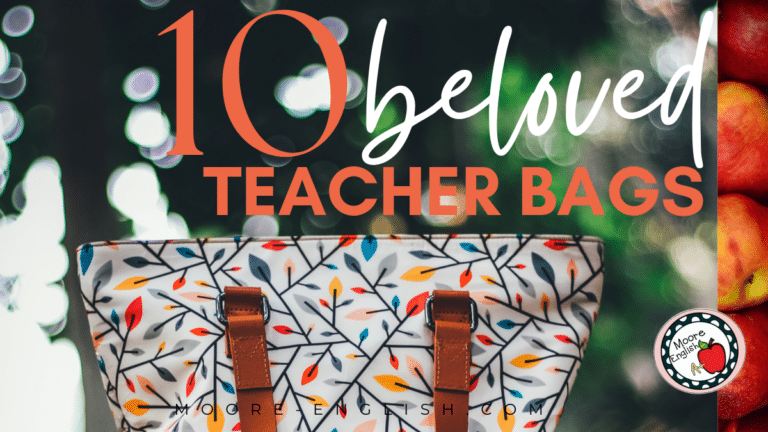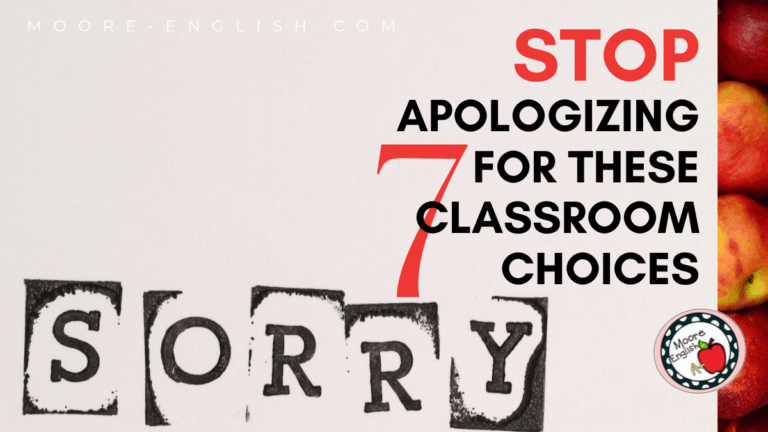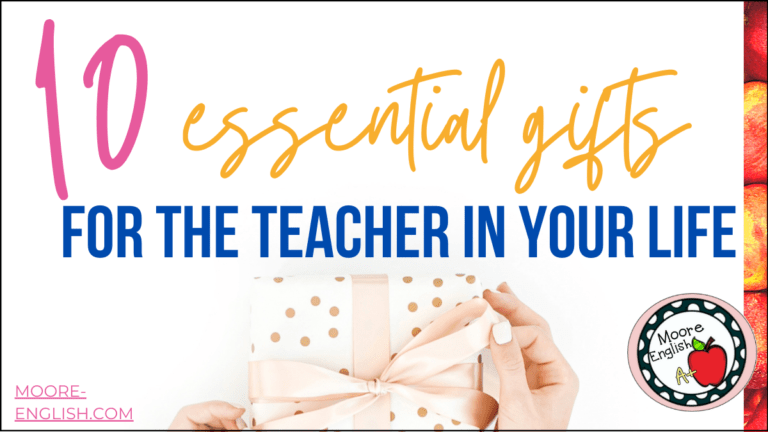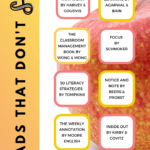Earlier this week, I saw two different articles with holiday book recommendations (here and here). While I was browsing, I began to think about what professional development books I would want to gift to other teachers. And that’s where this list was born!
While many of the professional development books on this list would suit any teacher, some of the titles are probably best for English language arts teachers. Regardless of which titles you choose, each one provides insights, ideas, and inspiration for busy, thoughtful teachers interested in personal and professional growth.
This post this post may contain affiliate links. Please read the Terms of Use.
Professional Development Books for Any Content or Level
My number one recommendation is Understanding by Design by Grant Wiggins and Jay McTighe. This is the text for backwards design! Everything is broken down into meaningful steps and templates. This is a planning book for any teacher, team, content, or grade.
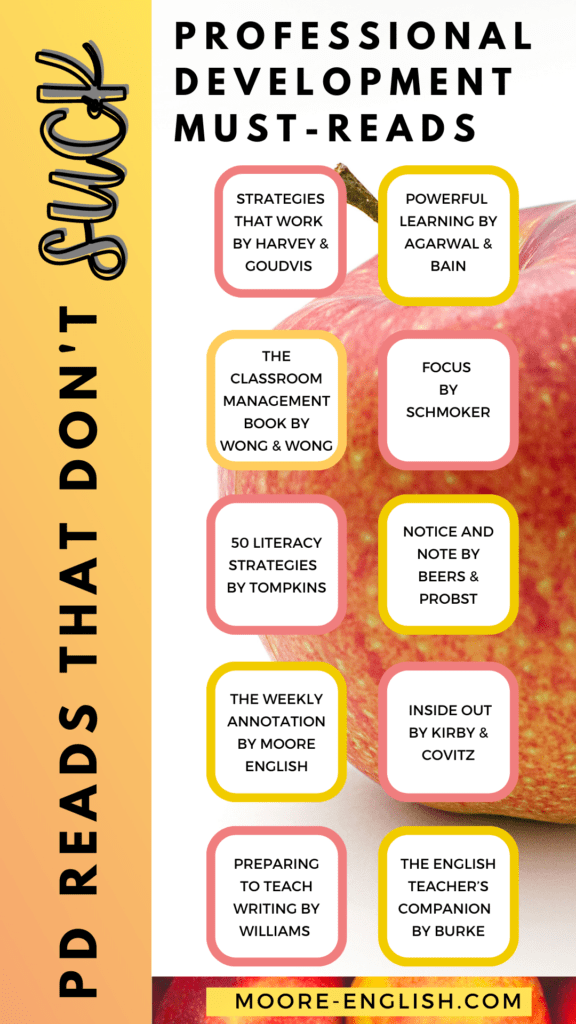
Powerful Learning by Pooja K. Agarwal and Patrice M. Bain is another recommendation for any content, grade, team or teacher! In this research-based book, the authors describe the value of retrieval practice in the classroom. I first learned about this strategy when Jennifer Gonzalez from Cult of Pedagogy interviewed Agarwal for her podcast.
Next to instructional strategies and loving your students, classroom management is one of the most important parts of teaching. In THE Classroom Management Book, Harry K. Wong and Rosemary Wong provide real-world advice to developing classroom management that works.
If I could bring a professional development book study to my building, I would argue for Focus by Mike Schmoker. First, this is a short read. And everyone knows that a required book study has to be brief. Secondly, Schmoker’s advice is practical. There are no gimmicks, just the need to make every moment of the too-short school year count.
Next, 50 Literacy Strategies by Gail E. Tompkins is a book I accidentally bought in college. My professor gave us the wrong list, so I bought this book. Being too lazy to return it to the bookstore, I kept it. And I am so glad I did! This is an easy-to-use collection of diverse strategies. The pages are also perforated like a workbook, so you can pull out specific strategies to include in your own curriculum guides.
Elementary Ideas for Everyone!
In the past, I’ve shared some of the best practice middle and high school teachers can borrow from our elementary friends. I have dinner with the women from my graduate school cohort every month. While all teach elementary school, their ideas often inspire my own teaching. These professional development books are the same: titles and recommendations for elementary teachers that also work for secondary teachers.
Firstly, Research-Based Methods of Reading Instruction by Sharon Vaughn and Sylvia Linan-Thompson outlines the five pillars of literacy. While secondary teachers may not work with phonemic awareness or phonics very often, word study, vocabulary acquisition, and reading comprehension are essential in all grades and content levels. The research discussed here is a great stepping stone for helping teachers improve instruction in these areas.
7 Keys to Comprehension by Susan Zimmerman and Chryse Hutchins is a perfect complement to Vaughn and Linan-Thompson’s writing. While elementary or reading teachers may be the target audience for this book, it’s important to remember that we are all reading teachers. The keys to comprehension are so important to remember even at the high school level. To this end, I have the keys included in my lesson plan template.
Finally, Strategies that Work by Stephanie Harvey and Ann Goudvis is a timeless professional development recommendation. When she retired, my mother passed this suggestion along to me, and I re-visit this book over and over again. I especially enjoy seeing my mother’s margin notes alongside my own!
Professional Development Books for English Language Arts Teachers
The English Teacher’s Companion by Jim Burke is one of my favorite professional development books for English language arts teachers. There are plenty of pie-in-the-sky titles for ELA teachers, but Burke’s experiences as an educator make his suggestions relatable and valuable.
“Close reading” is dangerously close to become an educational buzzword. Plenty of teachers say they’re teaching “close reading” without having any idea how to help teachers break down a text. That’s why Notice and Note: Strategies for Close Reading and its companion Reading Nonfiction: Notice and Note Stances, Signposts, and Strategies by Kylene Beers and Robert E. Probst are so helpful!
Preparing to Teach Writing by James D. Williams is one of the most academic recommendations on this list. Williams’ style is not always approachable. By that same token, Williams is not shy about busting myths and setting the record straight about what it takes to teach writing.
On the other hand, Inside Out: Strategies for Teaching Writing by Dawn Latta Kirby and Darren Covitz is the antithesis of Williams’ writing. While Williams focuses more on philosophy and pedagogical theory, Kirby and Covitz focus more on student creativity, innovation, and voice. In other words, Williams’ advice nurtures writing teachers while Kirby and Covitz nurture student writers.
One of the 8 Myths of Teaching Writing is the mistaken belief that students have internalized the writing process. Students have not internalized this process, so each journey through an essay is an opportunity to bring students through the writing process. As a new teacher, I both believed students inherently knew the writing process and its value. I also had no idea how to teach the writing process, which is why 6 + 1 Traits of Writing: The Complete Guide by Ruth Culham is so valuable. Even though this text focuses on younger students, this is a great recommendation for teachers struggling to teach the writing process and for teachers needing mini-lessons and ideas for writing intervention.
What other professional development books should we add to our shelves?


Photos from Ivory Mix.


